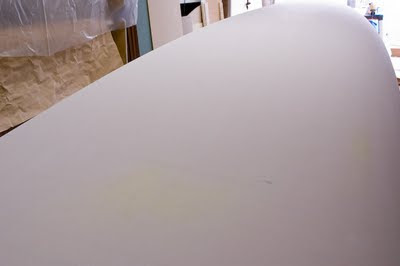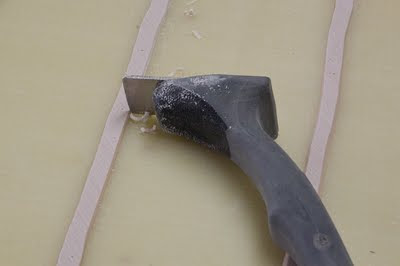The trip and getting back up to speed cut into the month, but I decided to start by using the Dremel and filling obvious bubbles before I finished sanding. I like to finish sanding, not filling, but of course if you fill too early and find some more . . .
I was pleased with the result. Hopefully the picture shows how you can see through the QF as it thins (yellow foam/glass color).
A close up with pattern from the stitched glass tow's and even a vague stripe to the right which is a seam between foam strips.
I do continue to learn about fairing and the rigid longboard (LB). I started out thinking: sand end to end, then back, then repeat. But there are a few nuances I've picked up over the last two sides.
First, there is more than one fair shape. We would like the one chosen by the designer and the one that has the least added fairing weight. I know my first side was fair, but likely not the best I could do now at achieving the other two goals.
What I've recognized is that the curved areas thin first. (I've mentioned not feathering at deck and keel till the last step.) A more subtle area is the transition from bow section to center hull. I think my impression on the first side was that this meant I needed the slightly thicker QF between two thinning areas (thinning must mean it was high, right?). After all, when I checked it was 'fair'.
I've come to a different conclusion. The LB wants to remove high areas, easy to visualize on a flat surface. But on a complicated surface, say convex changing to flat changing to convex, the game changes. Let's assume that with a given grit and force, an equal amount of material can be removed. On a flat surface, the whole LB touches (for example 1 unit force/100 sq inches). On a curved surface, the area of LB that touches significantly decreases, and with equal force the amount of removed material increases significantly (1 unit force/5 sq in).
Now what happens is that instead of creating an ultimately flat surface, the LB actually accentuates the curve! More is removed at the convex curve area, and less at the flat area since more is left behind. It's fair, it just doesn't meet our other two goals.
The floats have convex curves and lots of flat (fore and aft), but no concave. This means that you have to compensate for the above phenomena by either decreasing the force over the convex areas, or doing a 'double stroke' (or triple) and sand the flat areas for more time. Note: this phenomena is even more pronounced when you are sanding the candy stripes by themselves, so that you start at a disadvantage which only becomes more pronounced.
(Likely, someone will make the argument, "that's what a flexible board is for." I suppose. But then you have still more variables to control: stiffer for subtle curves? more flexible for tighter curves? should you still vary the force applied? . . . And I don't like flexible boards on the flat – which is really what you have a lot of.)
In retrospect, it seems so obvious. I think when I started that I was blinded by the sand, sand, sand, and the idea that "if it's fair, I must be doing it right."
There is also variable hardness in the QF depending when you get back to sanding. Although it cures enough to hand-sand at ~3 hours, it continues to cure to a harder state over the next several days. You can use this to your advantage by going after the mini-bubble fills early. But it can also be a disadvantage if you're sanding a larger fill patch where it is removed preferentially in comparison to the surrounding material with an advanced harder cure.
This is just a picture on the second side of how I try to put down the stripes. I use a Ziplock bag with the corner cut off at 45º. I've found that the sides have a seam, but the bottom doesn't. If you hold the bag with the bottom against the hull, the seam then makes the opening a triangle, giving the bead a nice wide base of attachment and a narrow top. The QuickFair is so good at keeping its shape that if you were to do it so the bead was round, it would not slough down, but cure with a narrow attachment and overhangs above. These would later just be voids, as it is very difficult to fill such small spaces.
Another time saver that gives superior results (gotta love something like that!) is to use a paint scraper or similar tool along the edge of the stripe instead of sanding. It straightens out imperfections, gives a perpendicular edge, and seems to be a perfect bonding surface. At least with my tool, I didn't notice any damage to the laminate. Remember, leaving the stripes high does not mean the final layer will be that thick!
I reread the email from Meno (posted in 'January', I recommend it). It's interesting that he went from stripes to simply troweling on material, and I've done the opposite. Of course it was his description of, "if you want to try candy-bag . . ." and listing some of the difficulties he encountered that has helped me feel that I've become successful enough with the candy-bag method. For me, an extra time investment to get the material on has been easier. Will I still think so after the main hull?
I proceeded to fill, then started making dust.





